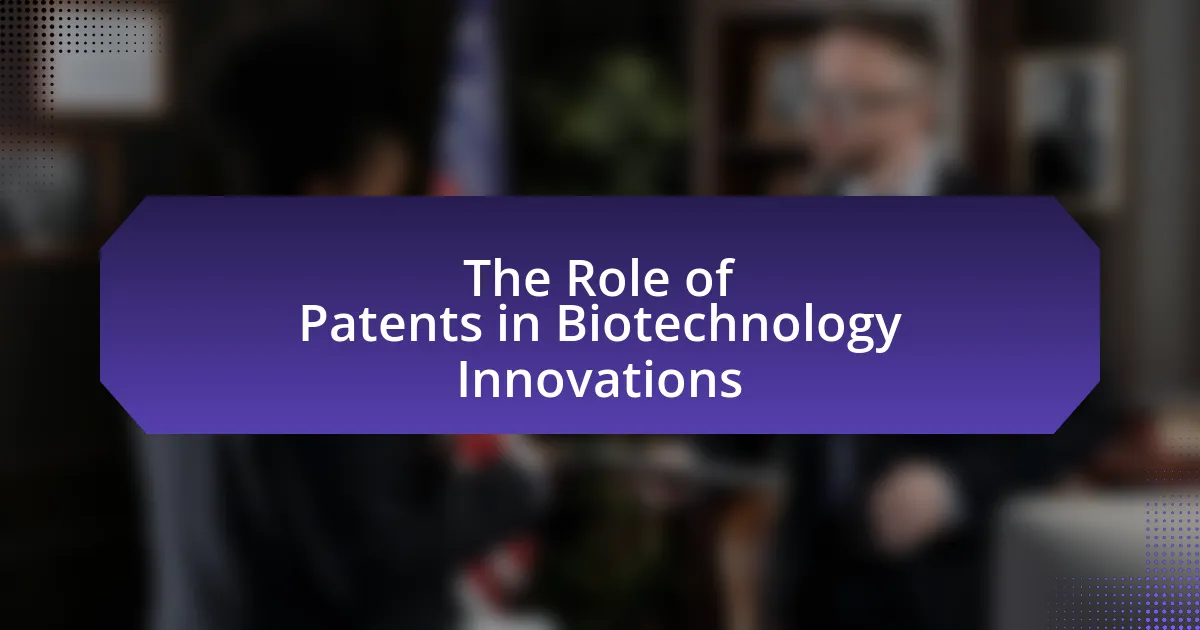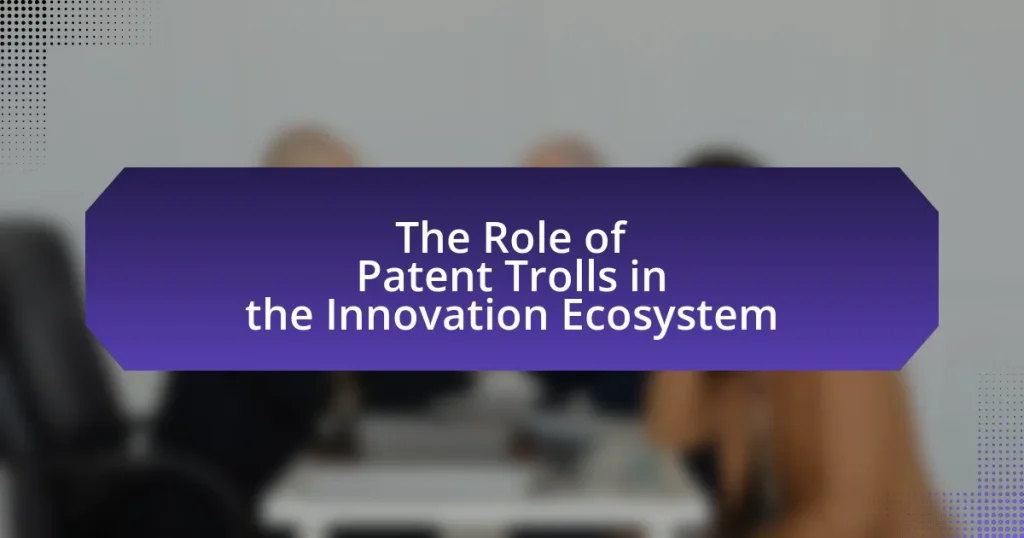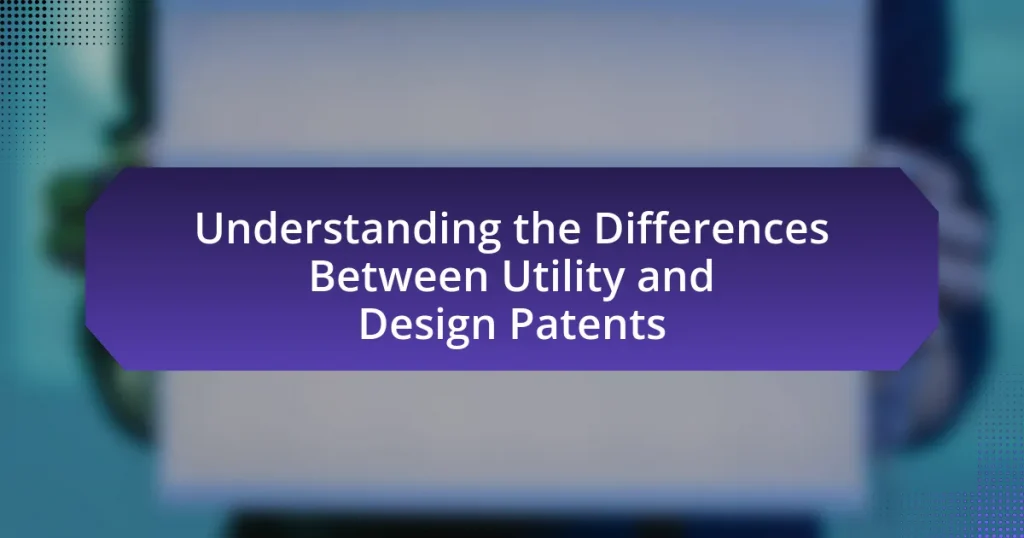Patents are a fundamental aspect of biotechnology innovations, providing legal protection that encourages investment and research in the field. This article explores the significant role patents play in fostering advancements in healthcare, agriculture, and environmental sustainability by securing exclusive rights for inventors. It examines how patents influence the development of biotechnology, the types of inventions they protect, and their impact on research and development. Additionally, the article discusses the financial benefits patents offer to biotechnology firms, the challenges faced in securing patents, and the implications of varying patent laws across different countries. By analyzing these components, the article highlights the critical relationship between patents and innovation in the biotechnology sector.
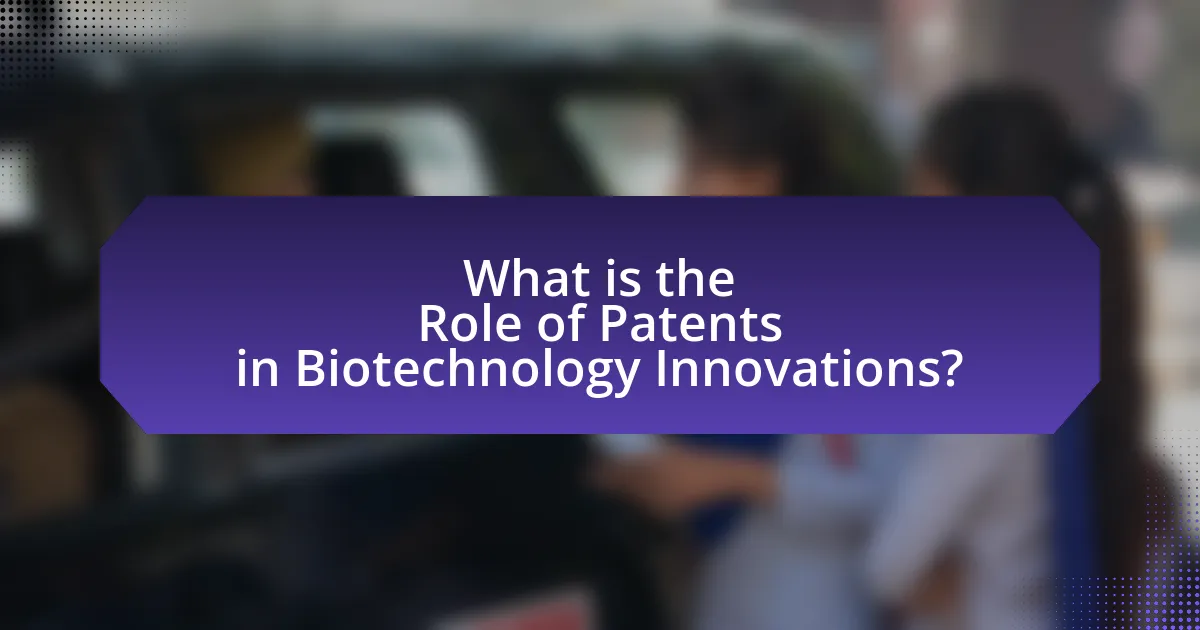
What is the Role of Patents in Biotechnology Innovations?
Patents play a crucial role in biotechnology innovations by providing legal protection for new inventions, which encourages investment and research in the field. This protection allows inventors to secure exclusive rights to their discoveries, thereby incentivizing the development of novel biotechnological products and processes. For instance, the U.S. Patent and Trademark Office reported that biotechnology patents have significantly increased, reflecting the industry’s growth and the importance of intellectual property in fostering innovation. By safeguarding proprietary technologies, patents help ensure that companies can recoup their research and development costs, ultimately leading to advancements in healthcare, agriculture, and environmental sustainability.
How do patents influence the development of biotechnology?
Patents significantly influence the development of biotechnology by providing legal protection for innovations, which encourages investment and research. This protection allows companies and researchers to secure exclusive rights to their inventions, thereby incentivizing them to invest time and resources into developing new biotechnological products and processes. For instance, the biotechnology sector has seen substantial growth, with the global market projected to reach over $1 trillion by 2024, largely driven by patented innovations in areas such as genetic engineering and pharmaceuticals. Furthermore, patents facilitate technology transfer and collaboration between academia and industry, as entities are more willing to share knowledge and resources when intellectual property is protected.
What are the key components of biotechnology that patents protect?
Patents in biotechnology primarily protect inventions related to biological materials, processes, and methods. Key components include genetically modified organisms, biopharmaceuticals, diagnostic methods, and bioprocessing techniques. For instance, the U.S. Patent and Trademark Office allows patents on novel genes, proteins, and methods of using them, as evidenced by the patenting of the BRCA1 gene associated with breast cancer. This protection incentivizes innovation by granting exclusive rights to inventors, thereby fostering advancements in medical and agricultural biotechnology.
How do patents affect research and development in biotechnology?
Patents significantly influence research and development in biotechnology by providing exclusive rights to inventors, which incentivizes innovation. This exclusivity allows companies to secure funding and invest in costly research processes, as they can expect a return on investment through market exclusivity. For instance, the biotechnology sector often requires substantial financial resources for research, and patents can enhance a company’s valuation, making it easier to attract investors. According to a study published in the journal “Nature Biotechnology,” patent protection has been shown to correlate with increased investment in biopharmaceutical research, leading to a higher number of new drug approvals. Thus, patents play a crucial role in shaping the landscape of biotechnology innovation by balancing the need for protection with the promotion of scientific advancement.
Why are patents essential for biotechnology companies?
Patents are essential for biotechnology companies because they provide exclusive rights to inventions, enabling firms to protect their innovations from competitors. This exclusivity fosters investment in research and development, as companies can secure a return on their investment by commercializing patented technologies. For instance, the biotechnology sector relies heavily on patents to safeguard biopharmaceuticals, with the U.S. Patent and Trademark Office reporting that over 50% of biotechnology patents are related to drug development. By ensuring that companies can maintain a competitive edge, patents encourage the advancement of new therapies and technologies, ultimately benefiting public health and the economy.
What financial benefits do patents provide to biotechnology firms?
Patents provide significant financial benefits to biotechnology firms by granting exclusive rights to their inventions, which can lead to increased revenue through licensing agreements and market exclusivity. This exclusivity allows firms to capitalize on their innovations without competition, often resulting in higher profit margins. For instance, a study by the National Bureau of Economic Research found that patented biopharmaceuticals can generate revenues that are 10 to 20 times higher than non-patented products, underscoring the financial advantage of patent protection. Additionally, patents can enhance a firm’s valuation, making it more attractive to investors and facilitating access to funding, as investors often view patented technologies as lower-risk investments due to their protected status.
How do patents contribute to competitive advantage in the biotechnology sector?
Patents contribute to competitive advantage in the biotechnology sector by providing exclusive rights to innovations, which prevents competitors from using the patented technology without permission. This exclusivity allows biotechnology companies to secure funding, attract investment, and establish market leadership. For instance, a study by the National Bureau of Economic Research found that firms with strong patent portfolios are more likely to receive venture capital funding, as patents signal the potential for future profitability and innovation. Additionally, patents can enhance a company’s bargaining power in licensing negotiations, further solidifying its competitive position in the market.
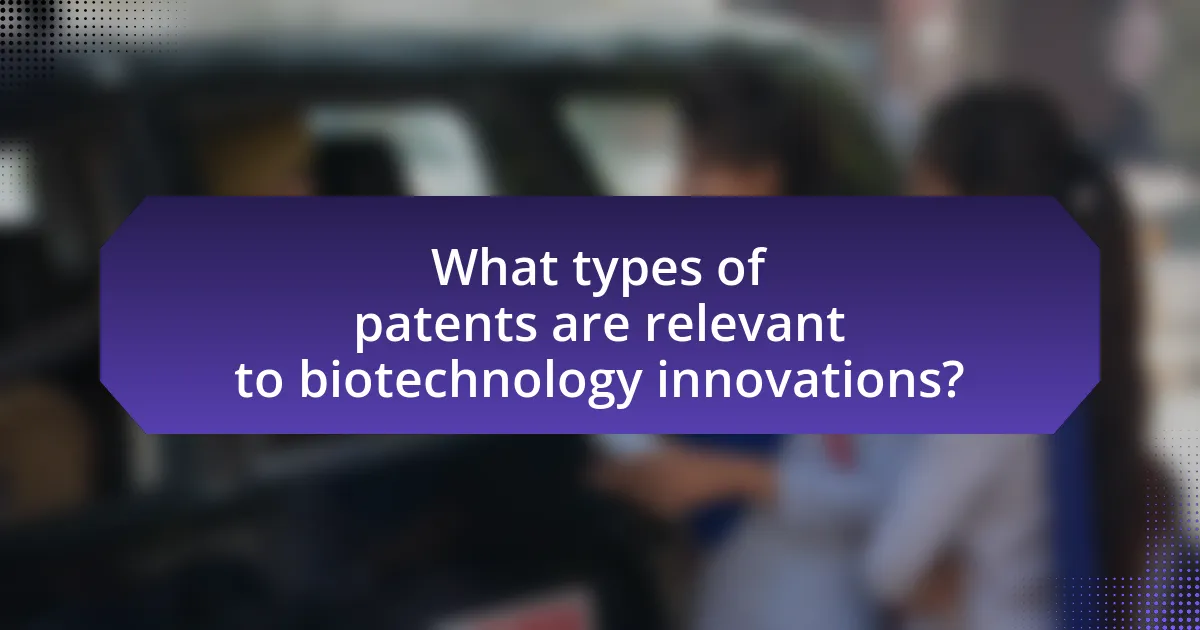
What types of patents are relevant to biotechnology innovations?
The types of patents relevant to biotechnology innovations include utility patents, plant patents, and design patents. Utility patents protect new and useful processes, machines, articles of manufacture, or compositions of matter, which is essential for biotechnological inventions such as genetically modified organisms or novel pharmaceuticals. Plant patents specifically cover new varieties of plants that have been asexually reproduced, allowing for the protection of innovations in agricultural biotechnology. Design patents, while less common in biotechnology, protect the ornamental design of a functional item, which can apply to biotechnological products with unique visual characteristics. These patent types collectively support the advancement and commercialization of biotechnology innovations by providing legal protection and incentivizing research and development.
What are the different categories of patents in biotechnology?
The different categories of patents in biotechnology include utility patents, plant patents, and design patents. Utility patents protect new and useful processes, machines, articles of manufacture, or compositions of matter, which are common in biotechnology for inventions like genetically modified organisms or novel pharmaceuticals. Plant patents specifically cover new varieties of plants that have been asexually reproduced, allowing for the protection of innovations in agricultural biotechnology. Design patents, while less common in biotechnology, protect the ornamental design of a functional item, which can apply to biotechnological products with unique visual characteristics. These categories are defined under U.S. patent law, specifically Title 35 of the United States Code, which outlines the criteria and protections available for various types of inventions.
How do utility patents differ from design patents in biotechnology?
Utility patents and design patents differ primarily in their focus and scope within biotechnology. Utility patents protect the functional aspects of an invention, such as processes, machines, or compositions of matter, which can include new biotechnological methods or genetically modified organisms. In contrast, design patents safeguard the ornamental design of a functional item, emphasizing its aesthetic appearance rather than its utility. For example, a utility patent might cover a novel method for producing a therapeutic protein, while a design patent could protect the unique shape of the container used for that protein. This distinction is crucial as it influences the type of intellectual property protection available for biotechnological innovations.
What is the significance of plant patents in biotechnology?
Plant patents are significant in biotechnology as they provide legal protection for new plant varieties, encouraging innovation and investment in agricultural research. By granting exclusive rights to breeders for a period of 20 years, plant patents incentivize the development of genetically improved crops, which can lead to enhanced yield, disease resistance, and environmental sustainability. For instance, the introduction of patented genetically modified organisms (GMOs) has revolutionized farming practices, allowing for more efficient food production. The U.S. Patent and Trademark Office reports that plant patents have facilitated advancements in biotechnology, resulting in a 20% increase in crop productivity over the last two decades. This legal framework not only fosters economic growth within the agricultural sector but also supports food security by promoting the development of resilient plant varieties.
How do patent laws vary across different countries for biotechnology?
Patent laws for biotechnology vary significantly across countries, influenced by local legal frameworks, cultural attitudes towards intellectual property, and economic strategies. For instance, the United States allows for broad patenting of biotechnological inventions, including genes and genetically modified organisms, under the Patent Act, which has led to extensive patenting in the sector. In contrast, the European Union has stricter regulations, particularly regarding the patentability of biotechnological inventions involving human embryos, as outlined in the Biotech Directive (Directive 98/44/EC). Countries like India have adopted a more restrictive approach, emphasizing public health and access to medicines, which limits patentability for certain biotechnological innovations. These variations reflect differing national priorities, such as innovation promotion versus public welfare, and are evidenced by the diverse patent landscapes observed in global biotechnology markets.
What are the implications of international patent treaties on biotechnology?
International patent treaties significantly influence biotechnology by establishing a framework for the protection of biotechnological inventions across borders. These treaties, such as the Agreement on Trade-Related Aspects of Intellectual Property Rights (TRIPS), require member countries to provide patent protection for biotechnological innovations, which encourages investment in research and development. The harmonization of patent laws under these treaties facilitates the commercialization of biotechnological products globally, ensuring that inventors can secure exclusive rights to their innovations for a specified period, typically 20 years. This exclusivity incentivizes innovation by allowing companies to recoup their investment costs. Furthermore, international patent treaties can lead to increased access to biotechnological advancements in developing countries, provided they implement the necessary legal frameworks to comply with these treaties.
How do regional differences in patent laws affect global biotechnology innovation?
Regional differences in patent laws significantly impact global biotechnology innovation by creating varying levels of protection and incentives for research and development. For instance, countries with strong patent protections, such as the United States, encourage investment in biotechnology by providing exclusive rights to inventors, which can lead to increased funding and innovation. Conversely, regions with weaker patent laws may deter investment, as companies face higher risks of intellectual property theft and reduced returns on investment. A study by the World Intellectual Property Organization (WIPO) indicates that countries with robust patent systems see a 20% increase in biotechnology patents compared to those with less stringent laws, highlighting the correlation between patent strength and innovation output.

What challenges do patents pose in the biotechnology field?
Patents in the biotechnology field pose significant challenges, primarily by restricting access to essential research tools and technologies. These restrictions can hinder innovation, as researchers may face difficulties in obtaining licenses for patented materials necessary for their studies. For instance, the broad patenting of genetic sequences can lead to a situation where multiple patents cover overlapping technologies, creating a “patent thicket” that complicates the development of new biotechnological products. Additionally, the high costs associated with licensing patented technologies can limit the ability of smaller companies and academic institutions to participate in research and development, ultimately stifling competition and slowing down advancements in the field.
What are the common obstacles faced by innovators in securing patents?
Innovators commonly face several obstacles in securing patents, including high costs, complex legal requirements, and lengthy application processes. The financial burden of patent filing and maintenance fees can deter innovators, especially startups with limited resources. Additionally, the intricacies of patent law require a deep understanding of intellectual property rights, which can be challenging for those without legal expertise. The application process itself is often prolonged, with many patents taking years to be granted, leading to uncertainty and potential loss of competitive advantage. According to the United States Patent and Trademark Office, the average time for a patent to be granted can exceed 24 months, highlighting the delays innovators encounter.
How does the complexity of biotechnology affect patentability?
The complexity of biotechnology significantly affects patentability by introducing challenges in demonstrating novelty and non-obviousness. Biotechnology often involves intricate biological processes and products, making it difficult to clearly define the boundaries of an invention. For instance, the U.S. Patent and Trademark Office requires that a biotechnological invention must not only be new but also sufficiently distinct from existing knowledge, which can be hard to establish due to the rapid advancements in the field. Additionally, the legal standards for patent eligibility, particularly under the U.S. Supreme Court’s decision in Mayo Collaborative Services v. Prometheus Laboratories, have heightened scrutiny on biotechnological inventions, emphasizing the need for a clear and specific application of scientific principles. This complexity can lead to increased uncertainty in the patenting process, as inventors must navigate both scientific intricacies and evolving legal interpretations.
What role does prior art play in the patent application process?
Prior art serves as a critical reference point in the patent application process by determining the novelty and non-obviousness of an invention. It encompasses all publicly available information related to the invention prior to the filing date, including patents, publications, and other disclosures. The existence of prior art can invalidate a patent claim if it demonstrates that the invention is not new or is obvious to someone skilled in the field. For instance, the United States Patent and Trademark Office (USPTO) requires a thorough prior art search to assess whether an invention meets the criteria for patentability, which is essential for maintaining the integrity of the patent system and fostering innovation.
How can biotechnology companies navigate patent disputes?
Biotechnology companies can navigate patent disputes by employing strategic legal and business approaches. These companies should conduct thorough patent landscape analyses to identify existing patents and potential infringement risks, which helps in formulating a proactive strategy. Engaging in licensing agreements can also mitigate disputes by allowing companies to use patented technologies legally. Furthermore, biotechnology firms can invest in alternative dispute resolution methods, such as mediation or arbitration, which are often less costly and time-consuming than litigation. According to a study published in the Journal of Biotechnology, companies that utilize these strategies can reduce the likelihood of prolonged legal battles and foster collaborative innovation.
What strategies can be employed to avoid patent infringement?
To avoid patent infringement, companies should conduct thorough patent searches and analyses to identify existing patents relevant to their products or processes. This proactive approach allows businesses to understand the scope of existing patents and design around them. Additionally, obtaining legal opinions from patent attorneys can provide clarity on potential infringement risks. Implementing a robust research and development process that emphasizes innovation and differentiation can further minimize the likelihood of infringing on existing patents. Regularly monitoring patent filings in the relevant field can also help companies stay informed about new patents that may affect their operations.
How can companies effectively manage patent litigation risks?
Companies can effectively manage patent litigation risks by implementing comprehensive risk assessment strategies and establishing robust legal frameworks. Conducting thorough patent landscape analyses allows companies to identify potential infringement issues and assess the strength of their own patents. Additionally, investing in legal expertise and maintaining a proactive approach to patent portfolio management can mitigate risks. For instance, companies that regularly review and update their patent filings are better positioned to defend against litigation. According to a study by the National Bureau of Economic Research, firms that engage in strategic patenting are less likely to face costly litigation, highlighting the importance of a well-managed patent strategy in reducing legal risks.
What best practices should biotechnology innovators follow regarding patents?
Biotechnology innovators should prioritize conducting thorough prior art searches before filing patents to ensure their inventions are novel and non-obvious. This practice helps identify existing patents and publications that could affect the patentability of their innovations. Additionally, innovators should draft clear and comprehensive patent claims that accurately reflect the scope of their inventions, as this clarity can prevent legal disputes and enhance enforceability. Regularly consulting with patent attorneys who specialize in biotechnology is also essential, as they can provide insights into evolving patent laws and strategies for protecting intellectual property effectively. According to the United States Patent and Trademark Office, a well-prepared patent application can significantly increase the chances of approval and reduce the likelihood of costly rejections or litigation.
How can companies ensure their innovations are patentable?
Companies can ensure their innovations are patentable by meeting the criteria of novelty, non-obviousness, and usefulness. To achieve novelty, companies must ensure that their innovation has not been previously disclosed or patented. Non-obviousness requires that the innovation is not an obvious improvement to someone skilled in the field, which can be demonstrated through comparative analysis with existing technologies. Usefulness means the innovation must have a specific, substantial utility, which can be supported by empirical data or practical applications. These criteria are established by patent laws, such as the United States Patent Act, which outlines the requirements for patent eligibility.
What steps should be taken to maintain patent rights effectively?
To maintain patent rights effectively, it is essential to regularly monitor and enforce those rights. Patent holders should actively watch for potential infringements by competitors and take legal action when necessary to protect their intellectual property. Additionally, timely payment of maintenance fees is crucial, as failure to do so can result in the expiration of patent rights. According to the United States Patent and Trademark Office, patents require maintenance fees at intervals of 3.5, 7.5, and 11.5 years after issuance to remain in force. Furthermore, keeping detailed records of the invention’s use and any licensing agreements can strengthen the patent holder’s position in case of disputes. These steps ensure that patent rights remain intact and enforceable, supporting ongoing innovation in biotechnology.
